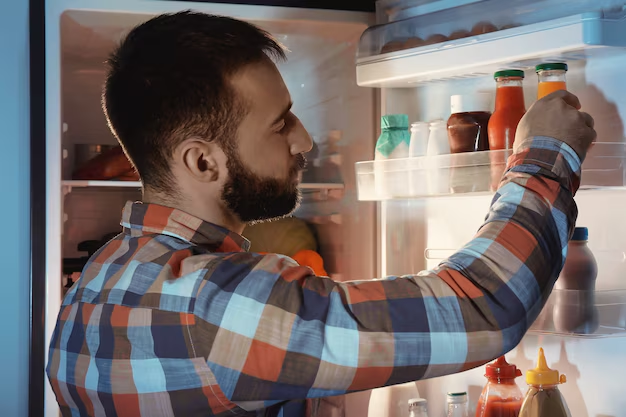Is Your Refrigerator Broken? Signs and Solutions to Consider
A refrigerator is more than just a kitchen appliance; it's an essential component of daily life. Imagine reaching for a refreshing drink only to discover your fridge isn't working as expected. A malfunctioning refrigerator can cause many headaches, from spoiled food to increased energy bills. But how can you tell if it's truly broken? Let's dive into some telltale signs, helpful diagnostic tips, and potential next steps you can take to ensure that chilling out in your kitchen remains a stress-free affair.
🛑 Warning Signs Your Refrigerator May Be Broken
Odd Noises Coming from the Unit
Most refrigerators emit a gentle hum or buzz, a sign that the compressor is working to keep your food chilled. However, if you begin hearing unusual noises like clacking, banging, or high-pitched whirring, it could indicate a problem. These sounds might result from malfunctioning fans or a compressor that's about to fail.
Key Takeaway: A sudden increase in noise levels can signal mechanical trouble that might require professional assessment.
Inefficient Cooling Performance
Your fridge's primary job is to keep things cool. If you notice that your beverages aren't as cold or your milk is spoiling faster than usual, the appliance might struggle to maintain its internal temperature. This can result from various issues, such as faulty seals that cause cold air to escape or issues with the thermostat.
Practical Tip: Check the door seals for any gaps or damage and ensure they're clean and in good condition. A quick DIY test is to close the door on a dollar bill; if you can easily pull it out, the seal is weak.
Ice Build-Up in the Freezer
While minor frost is normal, significant ice build-up can be a red flag. Over time, this excess frost can obstruct freezer vents and hinder overall cooling efficiency. This problem often ties back to defrosting mechanism failures or air leaks in the freezer compartment.
Consumer Insight: Regularly check for ice accumulation and defrost your freezer if needed. Persisting issues may require a deep-dive inspection into the unit's internal defrosting system.
Unexplained Increase in Energy Bills
Refrigerators are one of the highest energy-consuming appliances in a household. Noticeably higher electricity bills might indicate that your fridge runs inefficiently, possibly cycling more frequently due to a failing compressor or poor insulation.
Pro Tip: Monitor energy consumption using plug-in power monitors that provide an approximate report of your fridge's energy use. Anomalies might guide you to the specific malfunction.
Warmth and Condensation on the Exterior
Feel the exterior walls of your fridge. Warm spots or excessive condensation pockets hint that your refrigerator is struggling internally, possibly dealing with improper venting or inefficient heat dissipation.
Note: This symptom could suggest a more severe underlying issue that typically requires expert intervention.
🔧 Diagnosing and Troubleshooting a Broken Refrigerator
Step 1: Initial Observation and Inspection
Begin with a visual and tactile inspection. Look for signs outside and inside the fridge, as unusual smells, noticeable ice build-up, or visible fluid leaks can direct attention to specific problems areas.
Step 2: Test the Power Supply
Sometimes, the issue lies not within the appliance but the power supply. Check if the outlet is working correctly by plugging in another device. Additionally, examine the fridge's power cord for damages or wear and tear.
Step 3: Thermostat Check
Ensure that the thermostat settings haven't been inadvertently changed. Adjusting it to colder settings should trigger the refrigerator to produce cooler air. If not, the thermostat might be faulty.
Step 4: Clean the Coils
Dirty condenser coils can hamper efficiency, causing the fridge to overwork to cool down. Locate and clean these coils, typically found at the back or beneath the appliance, to see if there's an immediate improvement.
Step 5: Test the Temperature Sensors
Use a thermometer to double-check if the interior temperatures align with the set thermostat level. A discrepancy may indicate sensor issues or a more profound system flaw.
🚶 What to Do Next: Repair, Replace, or Seek Professional Help?
Evaluating the Cost of Repair vs. Replacement
If diagnosed problems lean towards costly repairs like a failing compressor, consider whether a new unit might offer better long-term value. While modern refrigerators have various energy-saving features, choosing a replacement means investing in technology that might better suit your needs.
Contacting a Professional Technician
For complex or dangerous tasks, professional technicians should always be consulted. They can offer a precise diagnosis and rectify issues safely and effectively, especially vital in handling refrigerants or electrical components.
DIY Fixables for the Adventurous Homeowner
If you're adept with tools, some troubleshooting tasks like replacing gaskets or cleaning coils are safely manageable by a responsible DIY enthusiast. Always ensure safety and consult model-specific manuals.
❗ Key Takeaways for Fridge Health Assurance
Engaging in regular maintenance can extend your refrigerator’s life. Keep these bullet points in mind:
- 🔍 Conduct regular checks for noise or vibration changes.
- 🧼 Clean condenser coils every few months.
- 💡 Observe door seal effectiveness.
- 🌡️ Use thermometers to monitor temperature accuracy.
- 💸 Watch for unusual energy consumption trends.
By staying vigilant and addressing small issues before they escalate, you'll help prolong your refrigerator’s service life while ensuring dependable food storage.
Protecting your refrigerator isn't just about maintaining an appliance; it's about safeguarding your food and peace of mind. By understanding the signs that your refrigerator might be struggling, you can take proactive steps to address minor problems before they balloon into major headaches. Remember, when in doubt, it's always wise to consult a professional to avoid compounding the problem or exposing yourself to safety risks. With a little attention and care, you'll keep your household chill and your fridge running perfectly for years to come.
